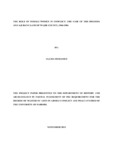| dc.description.abstract | A common assertion is that women are victims during conflict. Although often suggested,
women are not always victims. Sometimes they take part in the conflict yet this claim has
received little scrutiny. Hence, this study evaluates the roles of Degodia and Ajuran women in
conflict using the structural functionalism and actor analysis theories. These approaches hold that
armed conflict may generate feelings within members of society and examining whether the
feelings generate responses. This is what the study investigated in relation to the role played by
women during conflict between the Degodia and Ajuranof wajir county. This approach
distinguishes between some of the explanations given in previous literature. The most common
school of thought is that is that women are always the victims during conflict. But research has
shown that that the victims are also closely associated with conflict whose effects make them
more likely to participate in the real conflict .This work examines the main the factors that led to
the bloody conflict between Degodia and Ajuran of Wajir County,and has gone into great depths
to reveal that women are not always the victims in times of conflict. on the women side who end
up taking part in armed conflict. Adapting this approach enables an empirical distinction between
some of the explanations proposed in previous literature. These explanations are very diverse;
even so, they have not been separated systematically in previous empirical analyses. First, it is
hypothesized that women are victims during conflict. But research from elsewhere shows that
victims are also associated with conflict whose effects make them more likely to take part in
conflict.
This work discusses the main factors responsible for the entrenched conflict between the Ajuran
and the Degodia of North Eastern Kenya. The study revealed the adverse effects of the conflict
on the people of the region particularly in terms of insecurity that influenced the women to take
part in the conflict. It points out that Degodia-Ajuran of Wajir county conflict has undergone
fundamental transformation from a cultural practice to modern warfare organised and bankrolled
by warlords. The study also points out that the major losers in this environment of insecurity are
the small and poor peasants who have been pauperised and turned into destitute.
The study has also shown the multifaceted roles of women during the conflict situations in their
Degodia and Ajuran communities in Wajir as mediators, combatants, caregivers and even
economic providers for the family. As mediators the women have either individually or
collectively preached peace to the youths and men of their communities. They have appealed to
both the stake holders and the people of the community to lay down arms to negotiate. In terms
of care giving, the process includes not just the usual domestic affair of caring for the family and
home but, it also includes tending to the sick and wounded youths engaged in combating, caring
both emotionally and physically. | en |

